|
|
| home > files |
| Summer In_ Chicago Marialuisa Palumbo |
| [in italiano] |
From Sanford Kwinter's
Architecture of Time to Gilles Deleuze's The Fold, from Steven Johnson's
Interface Culture to Derrick de Kerckhove's Architecture of
Intelligence, from Roy Ascott's Architecture of Cyberception to
New Wombs. (1) These have been the main steps behind the theoretical thinking that has animated the
Summer Institute in Digital Media,
(2) organized by Ammar Eloueini and Doug Garofalo at the University of Illinois in Chicago, to which I was invited this year. |
[06aug2002] | ||
|
"What would it change in our arts, our science, and our technics if time were conceived as something
real?". In particular, what does it mean to introduce 'real time’ as a main variable of the morphogenetic process? With these questions in mind, as suggested by Kwinter's text, we began to investigate the relationship between design and new digital tools. In fact, if the Time issue is in itself essential for any reflection about the transformations caused by the digital in our way of living and inhabiting, this issue is even more essential for a design approach based, as in this lab, on animation software, Maya and Softimage, which are specifically oriented to 'capture' the time variable into their representation coordinates! 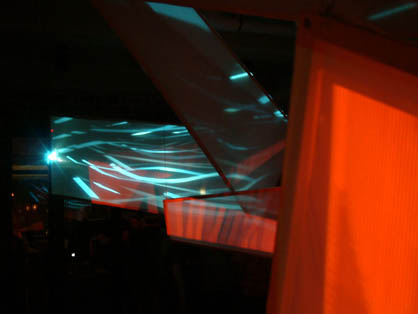 Among Kwinter's arguments, one seems to me especially clear: the 'domestic' ice cube versus the snow crystal genesis comparison. "Is time real for the ice cube in the same way as for the snow crystal? (...) In the former case a cube slot is prepared and performed in plastic or metal and filled with water (...) everything is locked into a static spatial system that reproduces a pregiven form. All the aleatory conditions, all of chance, hazard, all virtuality and sensitivity to other disturbances and changes in the environment -all wildness and opennes- are scrupulously (i.e., by design) eliminated. The snow crystal is different. (...) As the snow crystal falls it absorbs, captures, or incarnates all the chance events, all the fluctuating conditions (magnetic, gravitational, barometric, electrical, thermal, humidity, speed) and builds them, or rather uses them, to assemble itself, to form its structure or edifice. The snow crystal creates itself in the middle of, and by means of the convergence of, flux". |
(1) Sanford Kwinter,
Architecture of Time. Toward a Theory of the Event in Modernist
Culture, MIT Press, 2001; Gilles Deleuze, The Fold: Leibniz and the
Baroque, Univ. of Minnesota Pr, 1992; Steven Johnson, Interface Culture. How New Technology Transforms the Way We Create and
Communicate, Basic Books, 1997; Derrick de Kerckhove, The Architecture of
Intelligence, Birkhauser, 2001; Roy Ascott, The Architecture of
Cyberception, essay presented at ISEA '94, The 5th International Symposium on Electronic Art,
Helsinki; Maria Luisa Palumbo, New Wombs. Electronic Bodies and Architectural
Disorders, Birkhauser, 2000. (2) Summer Institute in Digital Media. Participants: Niccolo Casas, Colin Franzen, Eduardo Gomez, Zane Karpova, Siamak Mostoufi, Maria Regina C. Orig, Antonio Rodriguez, Chiara Tuffanelli. |
|||
  
|
As Kwinter affirms, carrying on with his argument, this analytical model –“based on developmental pathways, dynamical intersections, singular points, and qualitative movements in abstract, sometimes multidimensional space”- give us a new “theory of site”, and of the form/site relationship, which is extremely appealing and complex, but on the other hand the very concept of real time calls for another critical issue for contemporary design. In Johnson words: “we live in a society that is increasingly shaped by events in cyberspace [my italic], and yet cyberspace remains, for all practical purposes, invisible, outside our perceptual grasp. Our only access to this parallel universe of zeros and ones runs through the conduit of the computer interface, which means that the most dynamic and innovative region of the modern world reveals itself to us only through the anonymous middlemen of interface design". |
|||
|
If the issue of new possibilities of form generation is certainly a key one with respect to the use of new softwares to design in a digital environment (that is at the computer console), the issue of designing new interface systems between real space and information space is perhaps the most important innovation for an architectural 'program' that is suitable for the
digital era. To imagine and create architectural, and therefore spatial systems which will make new kinds of interaction possible and will generate passages between physical and digital space, is an issue that even if related to the genesis of new spatial forms, is perhaps more precisely concerned with the genesis of new zones of space, where the integration between the traditional building material and new technological elements (networking, circuits, screens, sensors...) make possible a new reactivity or interactivity of the space itself. As Ascott writes: "Instead of the planner's talk of streets, alleways, avenues, and boulevards, we need to think of wormholes, to borrow a term from quantum physics, tunnelling between separate realities, real and virtual, at many levels, through many layers". |
||||
|
Going back to the genesis of the ice cube and the snow crystal comparison as a strategy towards a new theory of place and architecture, the possibility of using the digital not only as a design environment but of integrating digital technology within architectural manufacture, let us imagine the conformation of a new kind of space which will stay, in time and beyond the moment of its formal conception, sensitive to events and to the progressive transformations of the complex local and global environment to which it belongs. Sensitive to human presence and capable, for instance, of giving access to an enlarged virtual space, and sensitive to the energetic flux which acts on buildings so to use them, for instance, to supply the energetic needs of their own metabolisms (as in the case of electric energy production). This is of course the theoretical position (and the summary report) corresponding to the person who is writing this and of course it would be necessary to say much more in order to recap two intensive weeks of work but, rather than trying an objective synthesis of everybody's point of view, I prefer once again to use this 'account' to focus on what I believe to be the key points of the debate on architecture and digital media. Is it possible to use not just the new softwares but more generally the new media to imagine and realize new species of spaces sensitive as much to human presence (and to the new hybrid dimensions of its existence) as much as to every other kind of force/stimulus? Is it possible to build a new architectural thought that ideologically sides towards objectives of substantial renewal as for instance in the case of energetic self-sufficiency through a dynamic reactivity of the skin to solar energy? Is it possible to move the debate on digital media from the centrality of formal innovation to the centrality of spatio-technological innovation? In other words, how can we use the new technologies to produce an architecture able to inhabit the Earth in a new way, or actually (and I'm intentionally using the word) in a better way as regards to the global balances of the extremely complex system we live in? |
||||
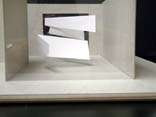  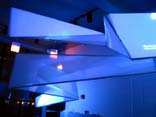 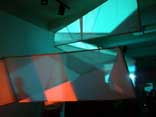 
|
To those who were in Chicago, but also to those who weren't there, let's sum up the thread of our dialogue and to draw some conclusions. I just want to thank Doug, Ammar again as well as the school for the invitation and their warm welcome! Below are a few more lines to briefly describe another aspect of this
experience... Beginning with the discussion of the previous ideas and in parallel to their development, this Summer Institute has been characterized by the design of a collective installation aimed at exploring a kind of spatialization of the image, through a three-dimensional projective surface estended within the projector light cone. |
|||
 The installation has given us an opportunity, albeit with limited time and technological resources, to work both on a simple kind of integration between real space (the physical location) and digital space (the projected image), as well as to bring about a constructive (hands on) experience. Together with the installation design and fabrication (in the end made of two video projectors and two articulated and suspended surfaces) each participant created a double animation for the projection, working at one and the same time on a strategy of physical occupation of the cone of projection (or deployment of projection in space) as well as on the design of a video animation whose image became disassembled and reassembled on the array of screen fragments in space. The chosen location is characterized by two glass walls that multiply and project the images towards the outside, visually reconnecting the installation to nearby downtown Chicago. Marialuisa Palumbo malupa@libero.it |
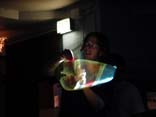 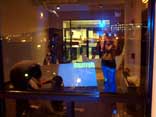 
|
|||